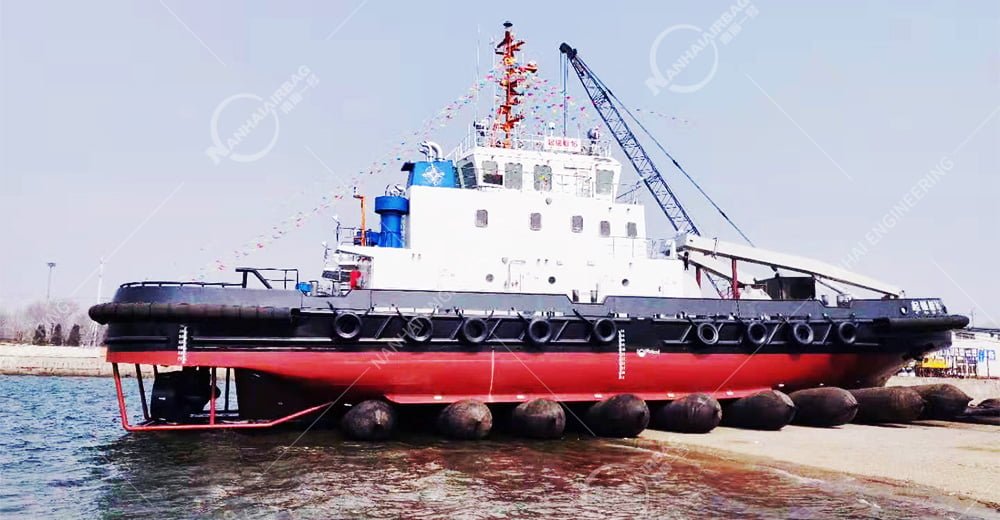Size Requirements When Purchasing Inflatable Fenders
06/21/2024Polyurethane Fender Structure
06/28/2024Ship Launching aAirbags: New Equipment To Improve Ship Safety
In the modern maritime industry, the safety of ships is always the primary concern. Whether it is daily operation or emergency rescue, ensuring the stability and safety of ships is crucial to preventing catastrophic accidents. As a new type of equipment, marine airbags are gradually becoming an important technical means to improve ship safety with their unique functions and advantages. This article will explore in depth the application of marine airbags in ship safety and how they escort modern marine transportation.

- Basic Overview of Marine Airbags
Marine airbags are usually made of high-strength rubber and multi-layer fiber materials, which can generate huge buoyancy and support after inflation. Its main applications include ship launching and launching operations, movement and transportation, and emergency rescue. The design of the airbag enables it to withstand huge loads under high pressure while maintaining high durability and tear resistance. - The role of marine airbags in ship safety
A. Safety guarantee for ship launching and landing
Traditional ship launching methods, such as slides and pontoons, usually require a lot of auxiliary equipment and precise calculations, and the slightest carelessness may cause damage to the ship or operational accidents. In contrast, marine airbags provide a safer and more controllable launching solution. By placing inflated airbags under the hull, the ship can slide smoothly into the water, avoiding the tilting and violent vibration that may occur during the launching process. Similarly, when lifting the ship from the water to the shore, the use of airbags can effectively reduce the stress on the hull structure and reduce the risk of damage.
B. The key role in ship rescue
In maritime accidents or disasters, marine airbags are widely used for emergency floating and rescue of ships. Whether it is a stranded, capsized or partially sunk ship, the airbags can be quickly inflated and generate sufficient buoyancy underwater to help the ship refloat or remain afloat. This function is particularly important for maritime rescue, which can buy precious escape time for crew and passengers while preventing further damage or complete sinking of the ship.
C. Reduce hull damage and maintenance costs
Ships often need to be moved and repositioned in ports or shipyards, and traditional methods of movement may cause wear and damage to the hull. Marine airbags provide a non-contact method of movement. By placing and moving airbags under the hull, ships can be smoothly transferred without direct contact with the ground. This not only reduces the wear on the outer coating of the hull, but also reduces the frequency and cost of maintenance and repairs.
D. Improve the stability of offshore operations
In some special marine engineering and operations, marine airbags can be used as temporary buoyancy aids. For example, during offshore construction, salvage or platform installation, airbags can provide additional buoyancy and support to enhance the stability and safety of the operating platform. This is especially important in complex sea conditions, which can prevent equipment from capsizing or sinking and ensure the smooth progress of operations. - Analysis of advantages of marine airbags
A. High strength and durability Modern marine airbags are made of multi-layer high-strength materials and have extremely high resistance to compression and tearing. They are able to maintain good performance in high-pressure environments for long periods of time, which is particularly critical for ships operating in rough sea conditions.
B. Flexible and simple operation The use process of marine airbags is relatively simple and does not require complex equipment and technical support. Through inflation and deflation operations, the position and height of the ship can be flexibly adjusted. This simplicity greatly improves the efficiency and safety of operations.
C. Adaptability and Versatility Airbag technology is suitable for ships of all types and sizes, from small yachts to large cargo ships and even ocean platforms. This wide adaptability makes marine airbags ideal for a variety of marine applications.
D. Economy and environmental protection The use of marine airbags can significantly reduce equipment and labor costs, while reducing the impact on the environment. Their operation does not require large mechanical equipment or construction works, thus minimizing disruption to the ecological environment. - Future Prospects of Marine Airbags
With the advancement of science and technology, the materials and designs of marine airbags will continue to improve to provide higher safety and reliability. In the future, intelligent and automated technologies may be integrated into the airbag system, enabling it to automatically detect and adjust the airbag pressure and status, further improving the safety and accuracy of operation.
In addition, as the global development and utilization of marine resources continues to deepen, the application areas of marine airbags will be further expanded. For example, in emerging fields such as offshore wind power, seabed mining and deep-sea exploration, airbag technology may play a more important role.
As a new type of safety equipment, marine airbags are changing the traditional way of ship operation and rescue. Their high efficiency, safety, flexibility and economy make them show great potential and value in the modern maritime industry. With the continuous development of technology, marine airbags will play a more critical role in future marine transportation and engineering, providing strong support for global shipping and marine development.
